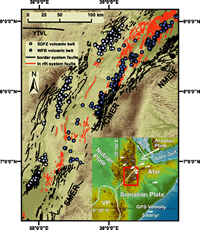Volcanic field elongation, vent distribution and tectonic evolution of continental rift: the Main Ethiopian Rift example
Mazzarini F., N. Le Corvec, I. Isola, and M. Favalli (2016)
Geosphere, 12/3, 1670-1700, doi:10.1130/GES01193.1
Abstract
Magmatism and faulting operate and interact in continental rifts at a variety of scales. The East African Rift, an example of an active magmatic continental rift, provides the ideal location to study the interplay between these two mechanisms. Previous work has shown that the distribution of volcanic vents and the shape of volcanic fields are linked to their tectonic environment and their magmatic system. In order to distinguish the impact of each mechanism, we analyzed four distinct volcanic fields located in the Main Ethiopian Rift; three of them (Debre Zeyit, Wonji, and Kone) are located within the rift valley, and one (Akaki) lies on the western rift shoulder. The elongation and shape of each field were analyzed based on their vent distribution using three statistical methods: the principal component analysis, the vent-to-vent distance, and the two-dimensional, symmetric Gaussian kernel density estimation method. The results of these analyses show that the elongations of the fields increase from the western shoulder toward the rift axis and are inversely proportional to their angular dispersion. In addition, we observed that none of the analyzed fields have elongation that parallels either the trends of the youngest faults or the volcano alignments. Dike intrusions inferred from the alignment analysis of volcanic centers that are located within the rift axis tend to parallel the orientation of the recent active faults. This parallelism, however, decreases from the rift axis toward the rift shoulder, which has a lower strain rate and shows a larger number of preexisting fault orientations. Our results suggest that the shape of volcanic fields in the Main Ethiopian Rift is controlled mainly by large crustal structures and/or by the lithosphere-asthenosphere–boundary geometry. Diking is principally controlled by the location of the field within the rift zone; intrusions within the rift zone are controlled mostly by the state of stress and strain rate; while intrusions on the rift shoulder are controlled mostly by the presence of preexisting fractures.
This study provides a combination of statistical analyses and geological observations to study and differentiate the mechanisms involved in the formation of volcanic fields on Earth and, potentially, other planets.


